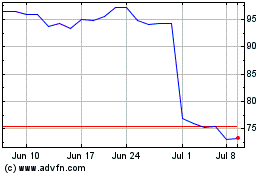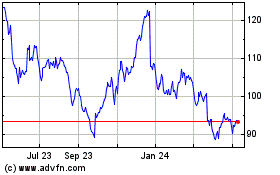Nike's Run Faces a Tough Climb
June 26 2016 - 12:12PM
Dow Jones News
By Sara Germano
Athleisure might be the style trend of the moment, but looking
sporty might not be enough for Nike Inc. when it reports fiscal
2016 results Tuesday.
Analysts have adopted an unusually bearish tone toward Nike with
at least four firms downgrading its stock within the past two
months. Among concerns: whether Nike's North American business can
continue to post sales growth amid rising inventory and
supply-chain stumbles, according to reports from Morgan Stanley and
Cowen & Co.
"The U.S. athletic apparel category is weakening and competition
is increasing," wrote Morgan Stanley analyst Jay Sole this month,
adding that the stock "doesn't fully account for the risk" of a
U.S. sales slowdown. Nike's shares have fallen 16% this year.
Analysts polled by FactSet expect profit to fall to $831 million
for the three months through May from $865 million a year earlier.
Revenue is forecast to rise to $8.3 billion from $7.8 billion.
Any hiccup would be unusual for the world's largest
athletic-gear maker, which has posted continuous quarters of
year-over-year revenue growth since the recession and is the clear
global market share leader in all footwear, according to
Euromonitor. Its most prominent endorser, basketball star LeBron
James, last week ended a 52-year title drought in Cleveland by
clinching the National Basketball Association championship for the
Cavaliers.
But the sportswear industry is going through a raft of changes
as competition intensifies. In the past year, several retailers
that carry Nike products have filed for bankruptcy protection or
liquidation. Nike's primary competitor, Germany-based Adidas AG, is
rebounding from its recent nadir, after a management shuffle and
heavy spending to boost sales in North America. Under Armour Inc.
is plans to move its global footwear operations to Nike's backyard
in Portland, Ore., and is making progress inn securing high-profile
athlete endorsements. Meanwhile, the women's athletic-apparel
market has ballooned to roughly 700 brands tracked by retail
analysts at NPD Group this year, as the athleisure trend
continues.
Nike watchers are also bracing for the formal resignation from
co-founder Phil Knight, who said this spring he would step down as
chairman in June and fully hand over leadership to Chief Executive
Mark Parker.
The company is pushing to reach an internal goal of $50 billion
in revenue by 2020, while doubling its sales to women and directly
to consumers over the same period. (Last fiscal year, Nike's sales
totaled $30.6 billion.) To do so, Nike is planning to launch a new
version of its Nike+ app, which will combine training tips and
workout tracking with a customized online store stocked with
coveted releases of limited-edition shoes.
Already, Nike's drive for more online and direct sales is
squeezing some of its longtime retail customers. The Sports
Authority Inc. and City Sports Inc. both filed for bankruptcy and
liquidation within the past year, in part because of tougher
competition for online sales. Mom-and-pop sneaker shops have said
they have trouble keeping up with big chains such as Foot Locker
Inc. in speed of ordering and securing coveted Nike product.
Another challenge, says Mr. Sole of Morgan Stanley, is the fact
that Under Armour has taken eight percentage points of
basketball-footwear market share from Nike, largely because of the
popularity of signature shoes for NBA Most Valuable Player Stephen
Curry. (Not to be confused with the latest release of a sneaker for
Mr. Curry, which was widely mocked.)
Nike, for its part, has been making changes and working toward
its lofty goals. It has shifted several management roles this
spring, most recently appointing company veteran Craig Zanon to
helm its global basketball category.
The management change follows a few worrisome signs in the
market. Foot Locker last month posted a rare decline in its core
basketball-shoe business, saying that sales of Nike signature
basketball shoes for Mr. James and fellow NBA player Kevin Durant
have slowed, in part because they are more expensive than Mr.
Curry's sneakers.
Write to Sara Germano at sara.germano@wsj.com
(END) Dow Jones Newswires
June 26, 2016 11:57 ET (15:57 GMT)
Copyright (c) 2016 Dow Jones & Company, Inc.
Nike (NYSE:NKE)
Historical Stock Chart
From Mar 2024 to Apr 2024

Nike (NYSE:NKE)
Historical Stock Chart
From Apr 2023 to Apr 2024
